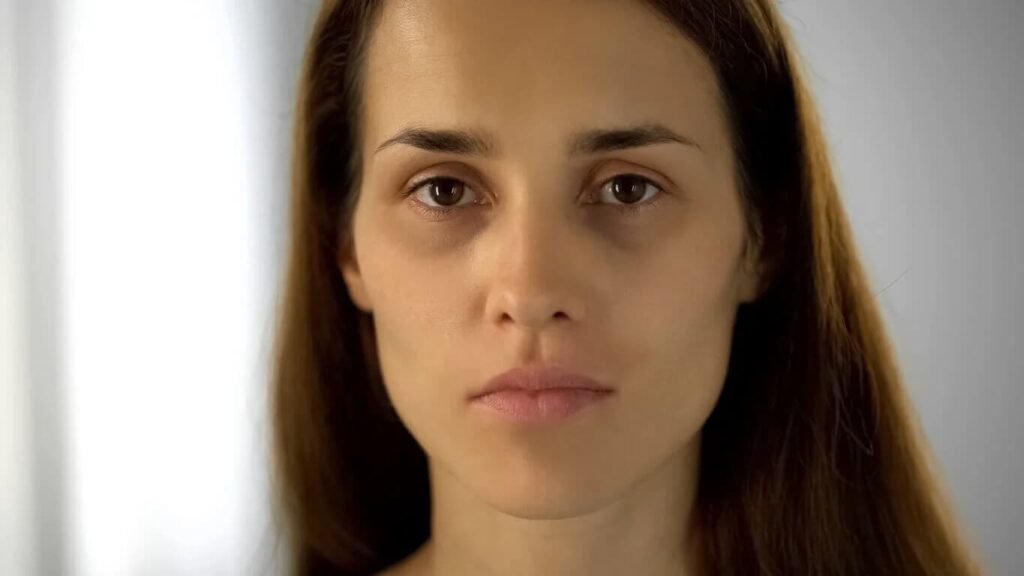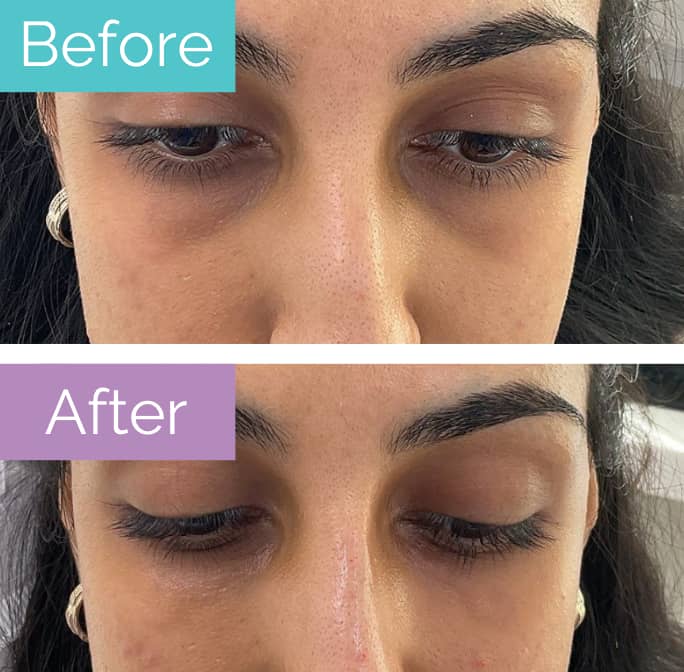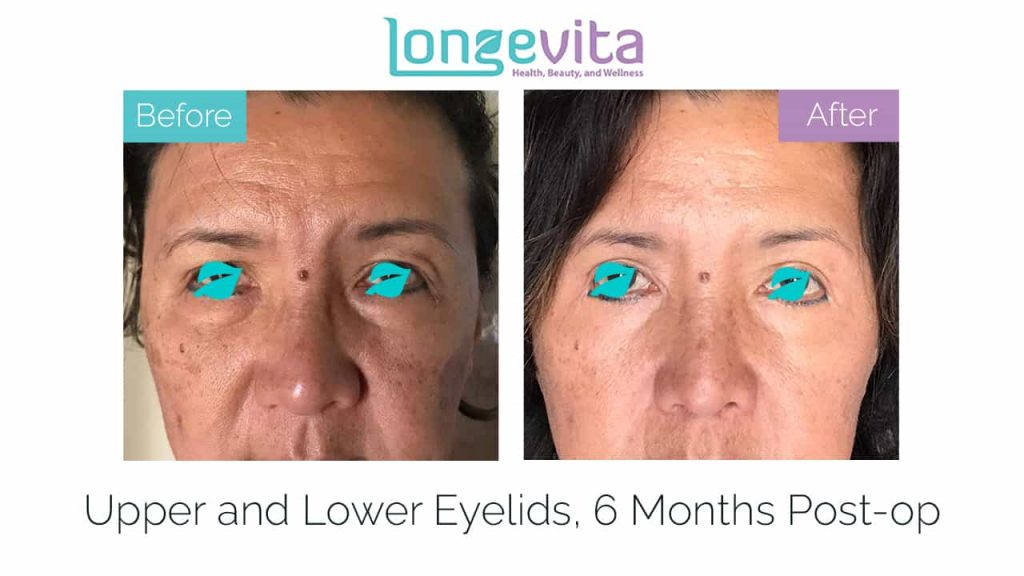There are many common under-eye problems, such as eye bags, dark circles, puffiness, wrinkling and hollowness. While all can be troubling, sunken eyes can make one look old, tired, sleepy and fatigued all the time.
Additionally, the sunken appearance of the eyes can exacerbate the circles underneath the eyes, which is something that many people find to be an aesthetic problem.
It is important to understand that sunken eyes can be caused by various factors. Before seeking treatment, you need to understand the cause of sunken eyes. Otherwise, you’ll end up being unsatisfied with the results of your treatment (non-surgical or surgical).
What Are Sunken Eyes?
Sunken eyes refer to the deep, concave hollow space between the lower eyelid and the upper cheek. It is also known as the tear trough deformity.

While it’s more commonly seen in adults, it is also possible for children to have them congenitally. Sunken eyes have a tendency to become more prominent with age due to changes in the skin.
Here, you should know that a tear trough groove is a natural part of the anatomy. It is formed as a result of the “tear trough ligament,” which tethers the skin to the underlying bone.
Therefore, the skin is naturally pulled down in that direction. However, in some people, it is more prominent than in others due to certain factors.
And unfortunately, the appearance of sunken eyes is something that many people find undesirable. The eyeballs can look recessed, making the area look gaunt. The skin also looks thinner than usual.
The way that light reflects in that concave area can also make the dark circles more prominent. Naturally, many people look for ways to get rid of them.
What Causes Sunken Eyes?
You will be able to make an informed decision when seeking treatment if you understand the underlying causes of sunken eyes.
Ageing
One of the most common causes of hollow eyes is age-related changes in the skin and body. Ageing causes the resorption of the bone socket which holds the eyes. As it grows larger in size, it provides less support to the overlying structures.
Additionally, the fat pads underneath the skin get displaced, which can further exacerbate the problem of sunken eyes. Your skin will also lose collagen and elastin, and the underlying muscles will also weaken.
That’s why ageing makes the hollows underneath the eyes more prominent. The changes in the curvatures of the skin also influence how light is reflected, changing how the tear trough appears.
Genetics
As mentioned above, tear trough deformity can also be seen in children. You can notice the presence of a prominent nasojugal groove (running diagonally from the inner corner of the eyes towards the cheeks).
It can run in families and be passed down by genetics. If your parents or grandparents have these under-eye grooves, you might too.
Enophthalmos
Enophthalmos is an abnormal sinking of the eyeball towards the back of the socket. It can be a result of physical trauma, HIV infection or periorbital fat (around the eyes).
It can also occur as a sign of breast cancer that has metastasized (spread). It is possible for it to affect one or both of the eyes, making them look sunken.
Weight Loss
Significant weight loss and malnutrition can also result in the loss of fat in the area around the eyes, which can make them look sunken.
The absence of fat can make the blood vessels in that area more prominent, which can further contribute to the problem of under-eye hollows.
Dehydration
Dehydration is another reason for having sunken eyes. You can experience dehydration as a result of prolonged sun exposure or even an infection.
Exercise also causes your eyes to appear tired and gaunt because you lose a lot of fluids.
Glaucoma Eye Drops
Prostaglandin analogues (PA) are a class of drugs that have been used in the treatment of glaucoma – a condition in which the eye’s optic nerve is damaged.
However, one side effect of PAs in glaucoma eye drops is that they can cause atrophy of fat, which can also make the eyes look sunken.
Allergies & Sinus Infection
It’s also possible for allergies and sinus problems to give you dark circles and prominent tear troughs. This can occur due to congestion and inflammation.
Rubbing the skin underneath the eyes can also worsen it by causing discolouration.
Unhealthy Lifestyle
Dark circles aren’t the only consequence of lack of proper sleep. It can negatively affect the skin around the eyes and also make them look sunken.
Smoking is another unhealthy habit that can cause this problem by causing the degradation of collagen and elastin.
Other than that, UV damage can also cause premature ageing, changing the texture of the skin around the eyes.
How To Fix Sunken Eyes?
Depending on the reason why you have under-eye hollows, your doctor may recommend one or more of the following sunken eyes treatments:
Dermal Fillers
Sunken eyes are commonly treated with tear-trough fillers. The hyaluronic acid in the dermal fillers puffs up the skin and pushes it outward.

However, this treatment is more suited for younger people who don’t have sunken eyes due to age-related skin changes.
When looking for a practitioner to inject tear-trough fillers, you need to be very careful. Make sure you find someone who is board certified and has the relevant experience.
That’s because if too much filler is added, it can make the eyes look puffy (even after the temporary swelling subsides).
Additionally, the filler needs to be injected at the right location keeping the tear trough filament in mind. The wrong injection can also cause skin trauma, resulting in discolouration of the skin around the eyes.
Here, you should know that dermal fillers usually last from anywhere between 6 months to 2 years. Before you get any maintenance injections, make sure to inform your doctor about the previous injections.
It’s possible that you may have some residual filler in place. If it’s not dissolved, the area will look overfilled.
Fat Transfer
Another way to treat the tear-trough deformity is to transfer fat to the area underneath the eyes.
For this, the doctor will have to harvest fat from different areas of your body, such as the thighs, abdomen, or buttocks. After it is purified, about 1mL of it may be injected under each eye.
Too much fat can make the skin look irregular. With this treatment, you should keep in mind that your body will absorb some of the fat; it can’t be said how much fat will be absorbed. Therefore, it’s not possible to predict the results. You may also need injections again to maintain the results.
Blepharoplasty
For older patients with fat pad displacement, weakening of the facial muscles, and sagging skin, a blepharoplasty will be more effective. The surgery will lift the skin and directly address these issues. Done on the lower eyelid, the results of the blepharoplasty will stay with you for a lifetime.

Infraorbital Rim Implant
Infraorbital rim implants offer another surgical solution to the problem of sunken eyes. In this, the surgeon will make an incision in the lower eyelid area to place an implant.
This will reshape the area and add volume to it. The results of this treatment are permanent. But finding a surgeon who places the implant correctly without causing asymmetry is crucial.

Medications
Tear trough deformity can also be a result of allergies, sinus problems and other health problems.
Therefore, your doctor may prescribe you antibiotics and anti-allergy medications to resolve this issue. You may not require any other cosmetic treatment.
Retinoids & Hydrating Creams
By boosting the production of collagen and elastin, it is possible for retinoids to slightly improve the appearance of hollow skin underneath the eyes.
You can also consider using creams that contain hyaluronic acid, amino acid or ceramides since they can hydrate the skin.
While these topical products can help with any hyperpigmentation or very mild wrinkling, they cannot reposition your fat pads or tighten your facial muscles. Therefore, if the problem is more severe, you should seek other non-surgical or surgical treatments.
How To Prevent Sunken Eyes?
If you’re born with tear trough deformity, there’s nothing that can be done, but, in some cases, you can prevent them by doing the following:
- Wear sunscreen to protect the skin underneath the eyes
- Quit smoking
- Drink lots of water to stay hydrated
- Get a good night’s sleep
- Eat healthy foods
Sunken eyes sometimes result from poor lifestyle habits and are only temporary.
Concluding Remarks
Sunken eyes can make you look dull, tired and old. For cosmetic reasons, many people seek different treatments.
Many also consider trying some at-home remedies like using teabags, potatoes, or cucumbers to improve their under-eye area. However, these may not work if the problem is the underlying structure.
Keep in mind that sunken eyes may be caused by age-related changes, trauma, illness, malnutrition, lack of sleep, smoking, dehydration, and even certain medications.
Before seeking treatment, you should understand what’s the reason behind your sunken eyes. And for that, it’s always best to consult a medical professional.




